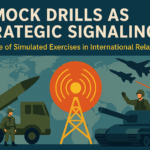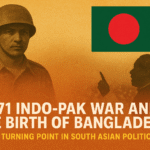The concept of ceasefire occupies a critical space in both international law and diplomatic practice. It represents a temporary or permanent suspension of hostilities between warring parties, often with the aim of creating conditions conducive to peace negotiations or humanitarian relief. While often used interchangeably with terms like truce, armistice, or peace agreement, each term carries a distinct legal and political implication. Understanding ceasefire from the perspectives of international law and international relations (IR) allows for a nuanced appreciation of its purpose, enforceability, and limitations in contemporary global politics.
Ceasefire vs. Truce, Armistice, and Peace Treaty
Although similar in practice, these terms differ in duration, intent, and legal weight:
- Ceasefire: A general or local halt in hostilities that may be temporary or indefinite. It may be declared unilaterally or agreed upon by parties without necessarily leading to the end of the conflict. It can be part of confidence-building measures or mechanisms to allow humanitarian access.
- Truce: Often a short-term pause in fighting, frequently localized or limited in scope. A truce is generally tactical and not necessarily political, allowing parties to regroup, collect the dead, or address immediate issues.
- Armistice: A formal agreement between warring parties to stop fighting. It is legally binding and often precedes a peace treaty. The 1953 Korean Armistice Agreement is a prominent example.
- Peace Treaty: A comprehensive, legally binding document that ends a state of war, involving negotiations over territorial, political, and economic terms.
The concept, therefore, lies somewhere between a truce (tactical and short-term) and an armistice (strategic and formal), often serving as a gateway mechanism to conflict resolution.
Ceasefire in International Law
There is no standalone international treaty governing ceasefires. However, cease-fires are governed through customary international law, UN Charter provisions, and international humanitarian law (IHL) frameworks:
1. UN Charter Provisions
- Chapter VI and Chapter VII of the UN Charter empower the UN Security Council (UNSC) to recommend or mandate cease-fires under “Pacific Settlement of Disputes” or in the context of threats to international peace and security.
- Article 39 allows the UNSC to determine the existence of any threat to peace and to take measures, including ordering a cease-fire.
- UN Security Council Resolutions (e.g., Resolution 242 after the 1967 Arab-Israeli War) often contain ceasefire demands backed by international legitimacy.
2. International Humanitarian Law (IHL)
- The Geneva Conventions (1949) and their Additional Protocols emphasize protection of civilians and encourage cease-fires for humanitarian access.
- Article 3 common to the Geneva Conventions suggests humane treatment during non-international armed conflicts and implicitly supports ceasefires for humanitarian purposes.
- Cease-fires may also enable “humanitarian corridors”, prisoner exchanges, or medical evacuations under IHL obligations.
3. Customary Law and Bilateral Agreements
- Many cease-fires are documented through memoranda of understanding, bilateral treaties, or protocols that form part of peace processes.
- These agreements may be brokered by third-party states, regional organizations (e.g., AU, ASEAN), or international organizations (e.g., UN, OSCE).
Grounds for Breaking a Ceasefire
While cease-fires are legal commitments, their breach does not automatically constitute an act of war, especially if the agreement lacks international recognition or clear enforcement mechanisms.
A state may break a ceasefire if:
- The opposing party violates key provisions – such as troop movements, continued shelling, or breaches of territorial boundaries.
- Security threats persist or escalate, making self-defense justifiable under Article 51 of the UN Charter.
- The cease-fire is conditional, and the agreed terms (e.g., withdrawal, disarmament, or access) are unmet.
- Cease-fire violations by non-state actors provoke state responses, especially in asymmetric conflicts.
- Political shifts or breakdowns in trust lead to reinterpretation or withdrawal from informal agreements.
However, such actions may face international scrutiny or condemnation if they escalate into unjustified aggression or violate humanitarian norms.
Ceasefire and International Relations (IR)
From an IR perspective, cease-fires are strategic instruments rather than purely legal tools. They serve both conflict management and power balancing purposes:
1. Realist Lens
Realist theory sees ceasefires as temporary halts in pursuit of long-term strategic interests. Warring parties may agree to ceasefire to:
- Regroup militarily
- Consolidate territorial gains
- Gain international legitimacy or delay defeat
2. Liberal Institutionalism
Ceasefires can be confidence-building mechanisms leading to dialogue and eventual peace. Institutions like the UN, EU, and regional bodies are seen as facilitators of such agreements.
3. Constructivist View
Constructivists argue that ceasefires reflect shared norms of restraint and are shaped by identity, legitimacy, and diplomacy. Ceasefire adherence often depends on the credibility of mediators and the normative pressure exerted by global actors.
Enforcement and Monitoring Mechanisms
- UN Peacekeeping Missions often include ceasefire monitoring mandates (e.g., UNIFIL in Lebanon, UNMOGIP in Kashmir).
- Regional bodies like the African Union and OSCE also deploy monitoring missions.
- Third-party mediation (e.g., by Norway in Sri Lanka or Russia-Turkey in Syria) includes verification teams and compliance reporting.
The success of enforcement depends on:
- Political will
- Clarity of terms
- Accountability mechanisms
Conclusion
Ceasefires, though inherently fragile, remain vital tools in the pursuit of peace. In international law, they rest on a blend of customary practices, humanitarian imperatives, and political consensus. In international relations, they are shaped by strategy, diplomacy, and trust-building. While ceasefires alone do not resolve conflicts, they can pave the way for dialogue, reconciliation, and long-term peace—if supported by inclusive negotiation, international legitimacy, and sustainable monitoring.





